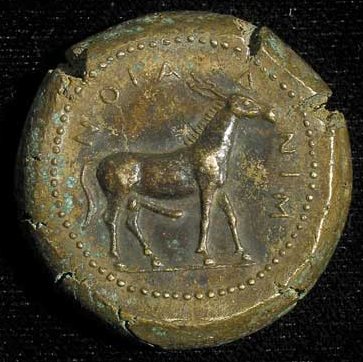 |
Fake Ancient Coin Dies |
|
| Update November 2006: The dealer has added a new 'hub' to the offering. This 'hub' is “most likely Berenike II, judging by the portrait”. Oddly, this 'hub' is made of “Lead(?)”!!! |
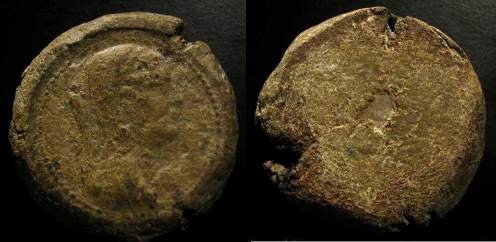 |
| Uniface lead token of dubious origin |
|
In 2004 Hollywood re-wrote ancient history twice. The movie Troy re-wrote Homer's epic Illiad. The surprise discovery of nearly 150 ancient Greek and Roman "dies" in a Los Angeles antiquities gallery was even more astonishing. The dies, of uncertain provenance, were not from a single period and region. The dies span nearly 1000 years -- right back to the beginning of coinage -- yet are remarkably similar in style and patina.
After ridicule from Arthur Brand on www.michelvanrijn.nl the dealer relabeled some — but not all — of the dies as "16th-19th century forger's dies". Some of the so-called dies were relabeled as "die hub"s — tools used to create dies. As of late 2005 the gallery web site still offers the dies, with prices ranging from $1000 to $9000.
Upon close photographic inspection, it appears most of these dies and hubs are unfit for striking fake coins. But why would a forger create unusable dies?
Most of the Los Angeles "dies" were never designed to forge coins. These dies were most likely created to defraud the antiquities dealer now trying to sell them! Fake dies, having only one side, may be easier to fake than coins " although, as we shall see, one of these dies is engraved on both sides.
In ancient times, mint workers engraved negative images directly upon coin dies. Modern mint works use a positive "hub" to strike many near-identical negative dies. Some of the "forger's dies" show signs of being struck by a positive hub (or possibly by a coin used as a hub). |
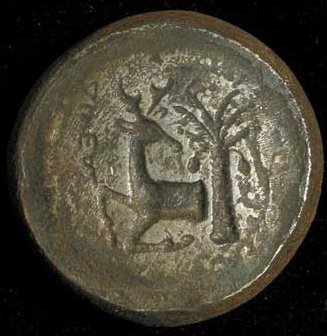 |
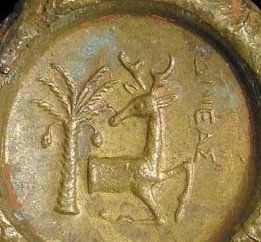 |
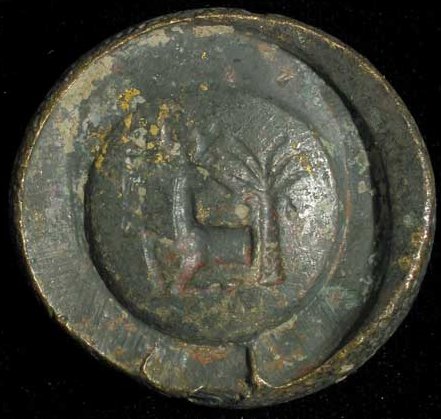 |
| Circular iron-colored die |
Patinated copper "hub" |
Patinated copper "die"pper "die" |
|
The circular die (above left) appears to be made of iron. This die looks usable for striking fake ancient coins.
The center hub has a "donut" fabric with circular depression exactly the size of the iron die. The donut-shaped fabric is a give-away that this hub was never intended to strike fake dies. During striking the die blank would flow, subjecting the donut to sideways forces that would crack the hub after a few strikes.
The third 'die' bears the same negative engraving as the iron die, but with less detail. Although the engraving is similar in size, the die is much larger, as if it was struck by a similar donut-shaped hub. Coins struck by this die might appear normal, but if the blank flan was large enough to make contact with the "die border" an odd crease would be struck into the coin. |
 |
| Linked Lysimachos tetradrachm hub and die. |
The Lysimachos tetradrachm hub (above left) is of reasonable fabric. It exhibits some splits from striking. When striking a die large enough to transfer them, the splits become features of the new die. When this hub struck the die (right) it left raised areas where metal flowed up into the cracks. |
 |
| Maussollos 'hub' |
| Sometimes the hub splits are so rediculous it's hard to imagine the "hub" ever being used to strike a die. This split happened when the hub was hot, soft and its metal capable of flowing — when this hub was struck by a mother die. Dies struck by this hub would have pie-shaped raised areas. |
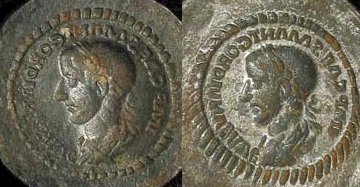 |
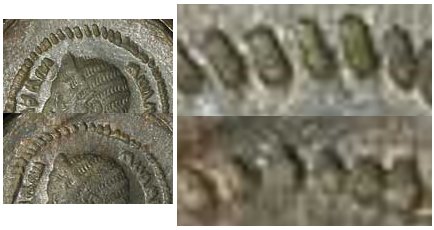 |
| Two Gordian II dies from the same hub. Note border distortion along bottom. |
Close up of two Julia Mamaea dies, from the same hub. Note the beads in the border have become oblong on the upper specimen. |
|
| These two Julia Mamaea dies bear identical portraits and legend, but the beads on the upper specimen have become elongated near the 12-o'clock position. The hub — or the coin used as a hub — may have distorted between strikings. |
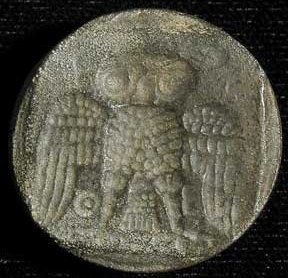 |
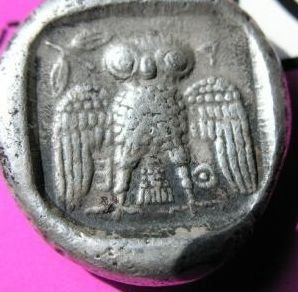 |
| Athenian dekadrachm reverse "die" |
Fake coin struck from a cousin of the reverse die |
|
| The dekadrachm reverse dies are unusual. Rather than using a square-shaped die, the reverse dekadrachm die is smaller than the incuse square! The corners of the incuse square would be 'radiused' and appear circular. Important corner details, like the olive sprig, are missing. This die could never have been used to strike a dangerous fake — it must then represent an end product itself. |
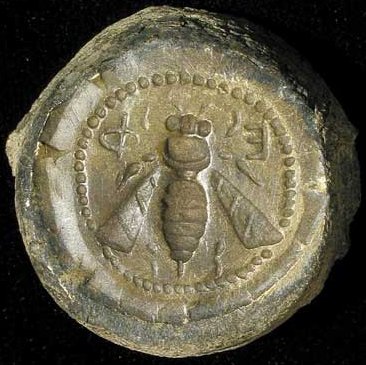 |
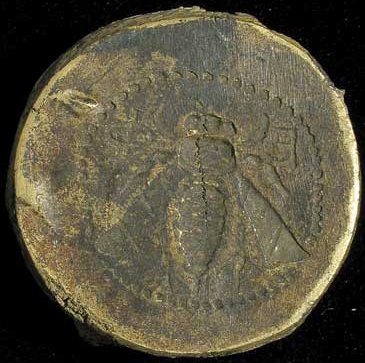 |
| One side of an Ephesos "die" |
The other side |
|
An Ephesos obverse die had an image at both ends. Striking one end with a hammer would have quickly obliterated the image, so it is likely this die struck few or no coins.
Coins struck in this manner would have a rim that looked like a hamburger, protruding from a smaller bun. I have only seen such a rim once on a hammered coin. A trihemiobol of Selge (of doubtful authenticity) has this feature. [INCLUDE PICTURE OF SELGE COIN AND RIM].
A catalog of the dies appears below. |
Die Catalog Greek |
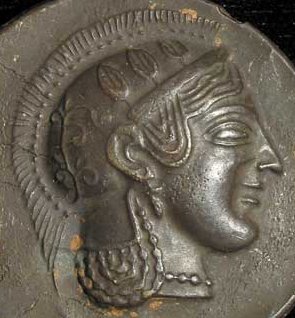 |
 |
| Athenian dekadrachm (hub) |
(coin) |
|
| An eBay seller offered the dekadrachm with the provenance 'Found at Kavadarci. Macedonia 1940' |
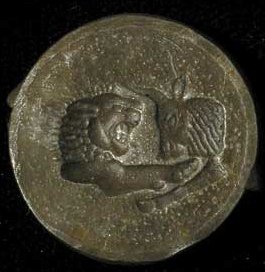 |
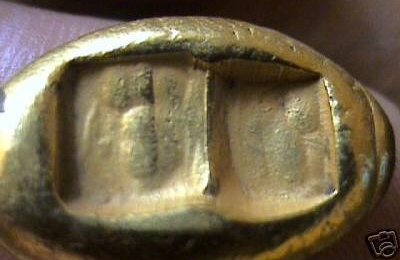 |
| Lydia lion/bull (die/reversed) |
(coin) |
|
The reverse is illustrated by a fake that appeared on German eBay in 2005. |
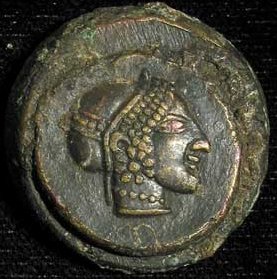 |
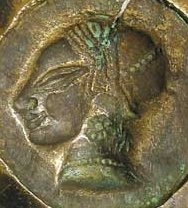 |
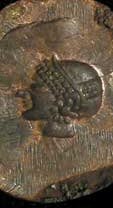 |
| Archaic female head (hub) |
Archaic female head (hub?) |
Archaic female head (die/reversed) |
|
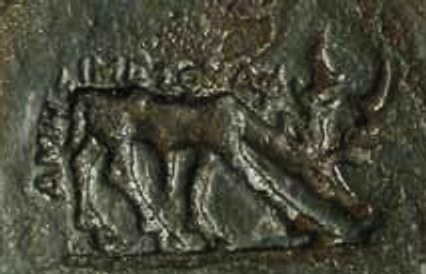 |
| 'Phanes' EL stater (die/reversed; 2x) |
| See http://www.thebritishmuseum.ac.uk/compass/ixbin/goto?id=OBJ4382 for photo of a genuine Phanes stater. |
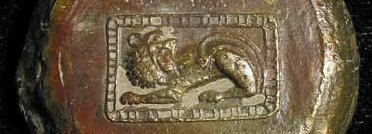 |
| Miletus electrum stater (hub) |
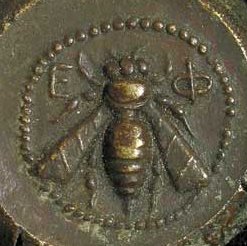 |
 |
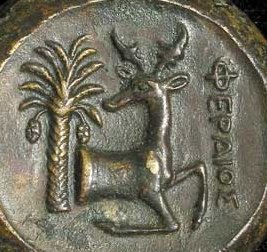 |
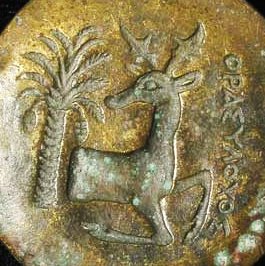 |
| Ephesos tetradrachm (hub) |
Reverse, magistrate DILIEAS (hub) |
Reverse, magistrate PhERAIOS (hub) |
Reverse, magistrate ORASYLOChOS (die/reversed) |
|
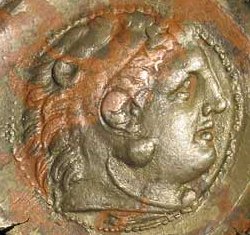 |
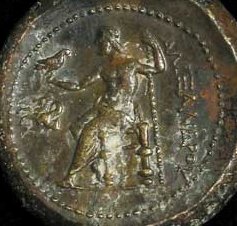 |
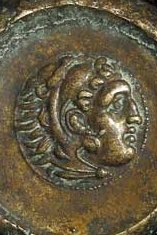 |
| Alexander tetradrachm (hub) |
Reverse (hub) |
Alexander drachm (hub) |
|
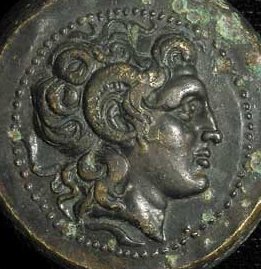 |
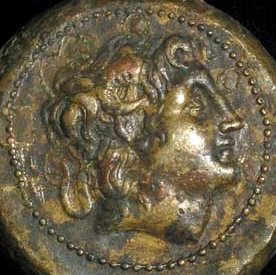 |
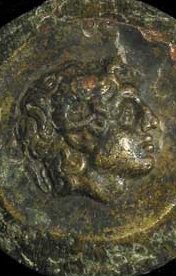 |
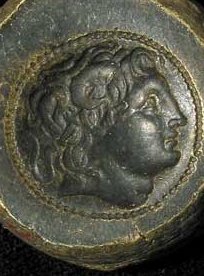 |
| Lysimachos tetradrachm (hub) |
another (hub) |
another (hub) |
another (die/reversed) |
|
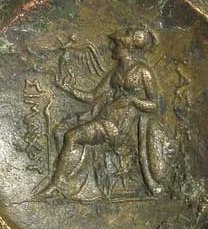 |
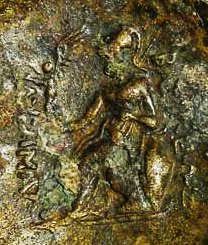 |
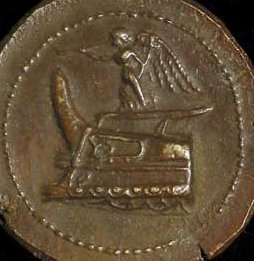 |
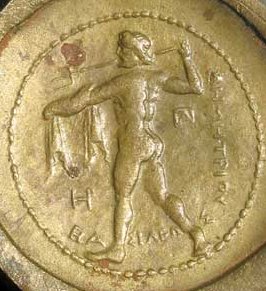 |
| Lysimachos reverse (hub) |
another (hub) |
Demetrius Poliorcetes (hub) |
reverse (hub) |
|
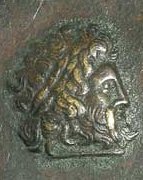 |
 |
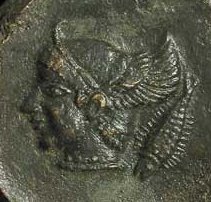 |
 |
| Poseidon (Demetrius Poliercetes?) (hub) |
Athens stater? (hub) |
Unidentified winged head l, fish behind (hub) |
Mende tetradracm (hub) |
|
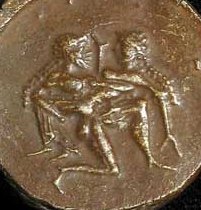 |
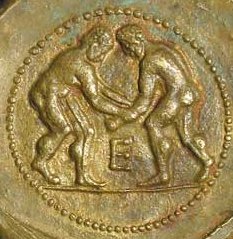 |
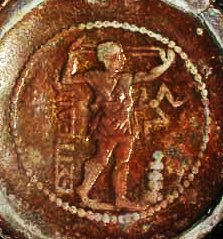 |
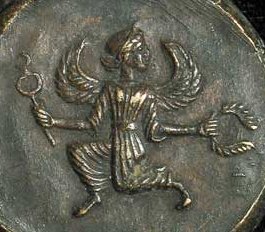 |
| Thasos stater or drachm (hub) |
Aspendos stater (hub) |
reverse (die/reversed) |
Cilicia, Mallos (hub) |
|
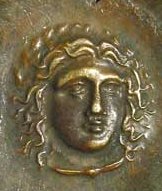 |
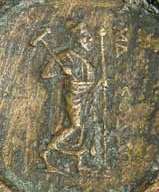 |
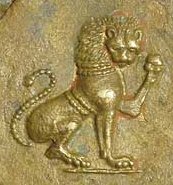 |
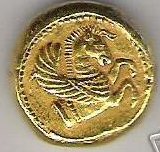 |
| Maussollos (hub) |
Maussollos (hub) |
obverse (hub) |
reverse (coin) |
|
 |
| obverse, toned (coin) |
|
| Both gold and silver fakes of this type have been spotted on eBay. |
 |
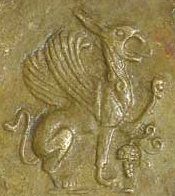 |
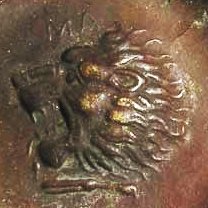 |
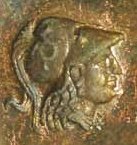 |
| Helios? (hub) |
Abdera or Teos, stater or tetradrachm, griffin (hub) |
Maussolos (hub) |
Athena in helmet (Side?) (die/reversed) |
|
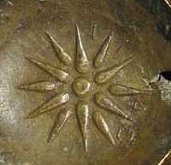 |
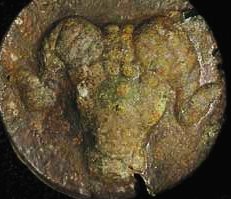 |
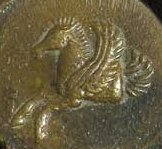 |
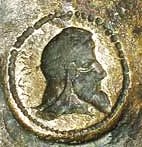 |
| Star with D (hub) |
Ram (die/reversed) |
Pegasos forepart (hub) |
Kherei (Lycian dynast) (die/reversed) |
|
Roman |
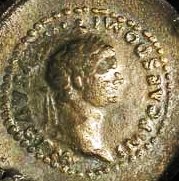 |
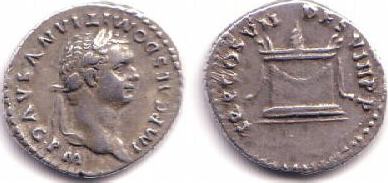 |
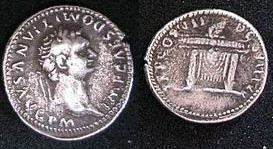 |
| Domitian (die/reversed) |
coin |
coin, different reverse |
|
 |
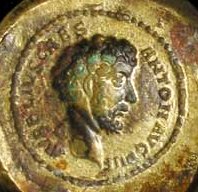 |
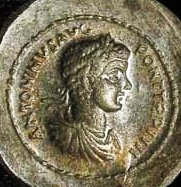 |
| Trajan (hub) |
Marcus Aurelius as Caesar (die/reversed) |
Young Caracalla as Augustus (die/reversed) |
|
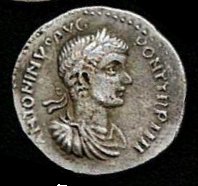 |
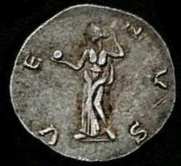 |
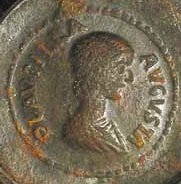 |
| coin |
coin reverse |
Plautilla, wife of Caracalla (die/reversed) |
|
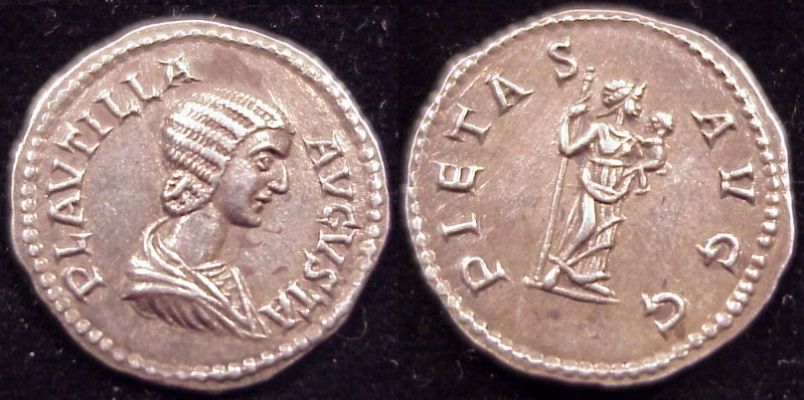 |
| coin |
| An aureus forgery of this Plautilla die was offered on eBay. |
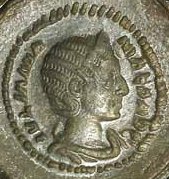 |
 |
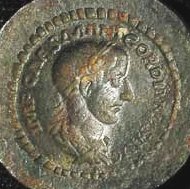 |
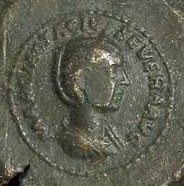 |
| Julia Mamaea, mother of Severus Alexander (die/reversed) |
Orbiana, wife of Severus Alexander (cracked 'hub') |
Gordian II (die/reversed) |
Otacilia Severa, wife of Philip the Arab (hub) |
|
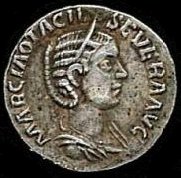 |
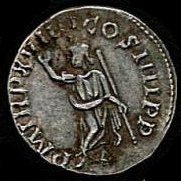 |
 |
 |
| coin |
coin reverse |
Gallienus (die/reversed) |
PRINC IVVENTVTIS-reverse.
|
|
| |
| |